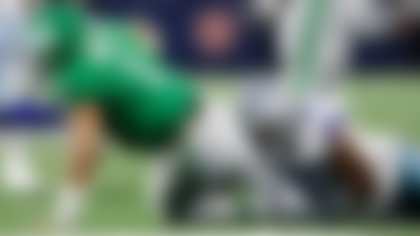RICHMOND, Va. -- Washington is running a goal-line drill. It's getting late in practice, but not so late that the players' bodies are completely worn down. Rookie quarterback Dwayne Haskins lines up behind center, takes the snap and play-actions to his left. Then he spins and rolls to the right, where wide receiver Brian Quick is running parallel along the goal line. Quick is covered closely, leaving the smallest of openings for the ball. Can Haskins fit the pass ... on the move ... into a tight spot ... just inside the sideline?
The question seemed ridiculous after the ball arrived on time and on target, just out of the reach of the defender, to a spot where only Quick could get it. It was the type of throw that, when done with regularity, infuses a franchise with the hope of what can be. In fact, the touchdown play elicited cheers from not only the fans who stood shoulder to shoulder along a waist-high chain-link fence, but also the defenders, who appreciated the skill it took to pull off the completion. One of them was rookie Jimmy Moreland, the ballhawking cornerback whose impressive offseason has carried over to training camp.
"Dwayne and I always push each other," he said afterward. "I tell him every day: 'If you make the right read and are on time, we're going to go far.' "
Far is relative in the NFL, where Washington has finished 7-9 the past two seasons. Injuries have been the primary culprit for the team's struggles, with health woes particularly undermining Washington's plans at the game's most important position. After starting last season at 6-3, Washington lost two quarterbacks (Alex Smith and Colt McCoy) to broken legs in the span of three weeks. By season's end, the team was starting a QB, Josh Johnson, who'd just been pulled from a charity basketball tournament. Unsurprisingly, Washington lost six of its final seven games. Furthermore, Smith's gruesome leg injury -- and the complications from multiple ensuing surgeries -- have put his future in doubt.
Enter Haskins, the former Ohio State star who was selected with the 15th pick in the draft. The 6-foot-4, 231-pounder has all the tangibles: size, a strong arm and the necessary agility to move in the pocket. He also has the intelligence, work ethic and composure to remain calm during duress.
Fans see throws like he made at the goal line or in one-on-one drills, and their appetite to see him in the starting lineup grows. It's apparent by how they scream his name, particularly when he turns and tosses up a peace sign at them. But Washington's coaches have no plans to rush him onto the field. Although short-term success could be critical to their job security, their focus is on the long-term development of Haskins, which is why they are preaching "process" during training camp.
"He came back from the break with an increased familiarity with the scheme and what we're trying to accomplish with concepts we're calling in the passing game; it has come a little more natural to him," head coach Jay Gruden said. "But it's still a process. Every day we might change a formation or [make] some minor tweak to a run-game concept or a pass-game concept that just doesn't register with him like it does with the other guys because they've been here. That's the tough thing for him. The more you work, the more familiar you get, but you've also got to be ready for the new stuff, which he's having a little bit of trouble with. But once he hears it and sees it again, he's fine."
Folks around the organization marvel at how mature and poised Haskins is. Oftentimes, teams will have a member of the PR staff sit in on interviews with high picks, particularly if that player is a quarterback. Not so in this case. Haskins has given them no reason to believe he can't handle himself. He looks his questioner in the eyes and answers every question directly. He does not talk as if paid by the word, choosing to make his points as economically and efficiently as possible.
Try to catch him off guard, and it's as if he saw the blitz coming before the snap of the ball. Like on Monday, when asked his definition of failure. "I would define it as an opportunity to learn from something to succeed," he said.
When was the last time he failed? Without hesitation, he responded: "I failed today when I was late on [a deep out route] on the field. Took two hitches. Next play, I won't fail again. I wouldn't count failure as a bad thing if you're learning from it and overcoming it. But if you continue to fail, then you're not making the change and you won't succeed."
Perspective is everything with a young quarterback. Haskins knows the team has veterans in McCoy and free-agent addition Case Keenum, whose experience gives them an early edge in the competition for playing time. The rookie wants as many reps as possible, but the decision as to when he'll play is not up to him. And he's OK with that. He has been through it before, sitting out his freshman season at Ohio State, then playing backup for a year.
"He has a great attitude," offensive coordinator Kevin O'Connell said. "If he gets more reps, less reps, you don't see a different Dwayne. He knows that this is all part of a big process. I go back to Ohio State and the growth he showed during his redshirt year that made the coaches so comfortable handing him the reins as a redshirt sophomore. I don't look at this as a mirrored process, but I look at it as, he's done the work before when he knew he wasn't going to be the guy, so you don't have any apprehension if it's, 'Hey, Dwayne, we're not going to start you right away. We're going to go with somebody else.' At the same time, it's, 'Hey, you're one snap away, or you're two snaps away; you need to prepare every single week for what it takes to be a pro through the whole game week.' "
"The biggest thing I learned from [sitting] was that my good wasn't good enough," Haskins said. "My dad always tells me, 'What you think is good isn't good enough for a coach or the expectations for a team.' It made me work harder."
Haskins has a personality that's like a magnet, drawing people to him. He has a smile that's as easy as his gait. During breaks on the field, you'll sometimes see him take a water bottle and squirt liquids down the necks of teammates. He even got defensive coordinator Greg Manusky, who still is seeking payback.
"I did it because he's always messing with me," Haskins said of the veteran coach, a wide smile on his face. "He talks into my helmet while I'm calling the plays. He's always doing stuff."
The fun and games stop when it's time to work. There is a heightened sense of urgency after consecutive losing seasons. Jobs could be on the line, for players as well as coaches. But even with that being said, Gruden and staff have no plans to play Haskins in the regular season unless he's ready. And there remains a lot of work to be done, such as ensuring he has a full grasp of the play-call terminology. That sounds rudimentary, but when you played in a college system featuring play calls that were generally four words or less, and now must authoritatively bark out calls that are a dozen words or more, it's more difficult than it sounds because it's hard to play fast when you're constantly thinking. Washington wants to get it to the point where things come naturally for Haskins.
They also want to put him in the best possible situation for success, which might mean sitting him for at least the first month-plus, because the early schedule is brutal. Four of the first five games are against playoff teams from a year ago, featuring upper-tier defensive units from Chicago, Philadelphia, Dallas and New England. The line also has issues, most notably the absence of seven-time Pro Bowl LT Trent Williams, who is holding out while seeking a trade. All of these factors explain why Washington is likely to slow-play the 22-year-old signal-caller in Year 1.
Haskins' focus is on controlling the things in his power, like how he works and prepares. He is a young man known for subscribing to the power of visualization, bringing to fruition his dreams of where he would attend college and even land as a pro.
"My first dream, of course, was to play quarterback at Ohio State. That was surreal for me, to the point where it went by so fast, I didn't get to enjoy it," he said. "Now that I'm here, I'm trying to do my best to be in the moment and have fun, to not have any expectations right away. That's probably the biggest thing I'm working on, as far as mentally knowing my time is coming. The same thing happened in college where I didn't play right away. Then when I did play, took it and ran with it."
He's hoping to replicate that progression in Washington.
Follow Jim Trotter on Twitter _@JimTrotterNFL_.












